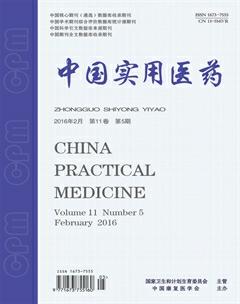昂丹司瓊對腹腔鏡膽囊切除術后惡心嘔吐的預防作用
周敏 張天偉


【摘要】 目的 觀察靜脈應用昂丹司瓊對腹腔鏡膽囊切除術后惡心嘔吐的預防作用。方法 100例全身麻醉下行腹腔鏡膽囊切除術的患者, 隨機分成昂丹司瓊組及對照組, 每組50例。昂丹司瓊組給予昂丹司瓊, 對照組給予生理鹽水。觀察兩組治療效果。結果 術后0~12 h惡心、嘔吐發生率昂丹司瓊組與對照組比較, 差異有統計學意義(P<0.05);昂丹司瓊組術后0~24 h惡心嘔吐發生率及挽救藥物用量顯著低于對照組, 差異有統計學意義(P<0.05)。結論 麻醉誘導前靜脈推注昂丹司瓊顯著降低了腹腔鏡膽囊切除術患者術后惡心嘔吐的發生率, 值得推廣應用。
【關鍵詞】 昂丹司瓊;腹腔鏡膽囊切除術;術后惡心嘔吐
DOI:10.14163/j.cnki.11-5547/r.2016.05.006
Preventive effect by ondansetron for postoperative nausea and vomiting in laparoscopic cholecystectomy ZHOU Min, ZHANG Tian-wei. Department of Anesthesiology, First Affiliated Hospital of Xiamen University, Xiamen 361003, China
【Abstract】 Objective To observe preventive effect by ondansetron for postoperative nausea and vomiting in laparoscopic cholecystectomy. Methods A total of 100 patients receiving laparoscopic cholecystectomy by general anesthesia were randomly divided into ondansetron group and control group, with 50 cases in each group. The ondansetron group received ondansetron, and the control group received normal saline. Curative effects of the two groups were observed. Results The difference of incidences of postoperative nausea and vomiting in 0~12 h had statistical significance between the ondansetron group and the control group (P<0.05). The ondansetron group had obviously lower incidences of postoperative nausea and vomiting in 0~24 h and applied content of rescue medicine than the control group, and the difference had statistical significance (P<0.05). Conclusion Intravenous injection of ondansetron before anesthesia induction can remarkable reduce incidences of postoperative nausea and vomiting in laparoscopic cholecystectomy. It is worth promoting and applying.
【Key words】 Ondansetron; Laparoscopic cholecystectomy; Postoperative nausea and vomiting
術后惡心嘔吐是腹腔鏡膽囊切除術(LC)后的常見并發癥, 腹腔鏡膽囊切除術后惡心嘔吐發生率為44%~83%[1, 2]。術后惡心嘔吐增加了患者的心理不適和術后恢復時間、導致傷口裂開延長住院時間。選擇性5-羥色胺3(5-HT3)受體阻斷劑對術后惡心嘔吐有良好的預防作用, 本研究擬探討昂丹司瓊對腹腔鏡膽囊切除術后惡心嘔吐的影響。現報告如下。
1 資料與方法
1. 1 一般資料 選取100例全身麻醉下行腹腔鏡膽囊切除術的患者(2012年5月~2014年12月期間病例)。排除標準:對本研究所用藥物過敏、伴有明顯惡心嘔吐的胃腸道疾病、術前24 h服用止吐藥的患者。患者進入手術室后, 常規監測無創血壓、心電和血氧飽和度、呼氣末CO2(ETCO2), 面罩吸氧3 L/min。100例患者隨機分為昂丹司瓊組和對照組, 每組50例。兩組患者一般資料比較差異無統計學意義(P>0.05), 具有可比性。見表1。
1. 2 方法 昂丹司瓊組靜脈應用昂丹司瓊8 mg(5 ml), 對照組給予生理鹽水5 ml。由于丙泊酚有抗嘔吐作用, 本研究誘導及維持均避免使用丙泊酚。本研究所用昂丹司瓊于麻醉誘導前緩慢靜脈推注。
麻醉誘導:咪達唑侖0.05 mg/kg、維庫溴銨0.1 mg/kg、芬太尼4 μg/kg、依托咪酯0.1 mg/kg, 吸氧去氮5 min, 置入喉罩, 并從雙管喉罩中置入胃管。連接呼吸機機械通氣, 術中ETCO2維持在35~45 mm Hg (1 mm Hg=0.133 kPa)。麻醉維持:七氟烷1.0~1.3 MAC、瑞芬太尼0.05~0.10 μg/(kg·min), 間斷靜脈推注維庫溴銨0.05 mg/kg, 術中CO2氣腹壓力維持在<15 mm Hg。術前30 min給予地佐辛5 mg做術后鎮痛。術終給予新斯的明1 mg、阿托品0.5 mg, 待患者完全清醒, 肌張力恢復良好, 充分吸痰, 拔除喉罩, 將患者送入恢復室, 面罩吸氧3 L/min。
1. 3 觀察指標 由麻醉護士于術后12、24 h分別回訪惡心嘔吐發生情況, 麻醉護士對研究所用藥物并不知情。術后惡心嘔吐的嚴重程度分為4級[3]:0級:無惡心嘔吐;1級:干嘔;2級:30 min內嘔吐1~2次;3級:30 min內嘔吐>2次。惡心定義為有想吐的主觀不適感覺而無嘔吐動作, 干嘔定義為有節律的胃部肌肉收縮但未嘔出胃內容物, 嘔吐定義為嘔出胃內容物。如果術后惡心嘔吐≥2級, 則給予胃復安10 mg作為挽救藥物。
1. 4 統計學方法 采用SPSS16.0統計學軟件對數據進行統計分析。計量資料以均數±標準差( x-±s)表示, 采用t檢驗;計數資料以率(%)表示, 采用χ2檢驗。P<0.05表示差異具有統計學意義。
2 結果
術后0~12 h惡心、嘔吐發生率昂丹司瓊組與對照組比較, 差異有統計學意義(P<0.05);昂丹司瓊組術后0~24 h惡心嘔吐發生率及挽救藥物用量顯著低于對照組, 差異有統計學意義(P<0.05)。見表2。
3 討論
腹腔鏡手術術后惡心嘔吐的病因學復雜, 包括多方面因素:年齡、肥胖、以前的術后惡心嘔吐史、手術操作、麻醉方式以及術后疼痛等[4]。腹腔鏡膽囊切除術中CO2氣腹可能是術后惡心嘔吐的原因之一, 其機制仍未明確。氣腹刺激了腸道的機械感受器, 增加了術后惡心嘔吐的風險。氣腹導致的腸道缺血致血清素和其他神經遞質釋放, 是術后惡心嘔吐的原因。長時間氣腹通過腦血管擴張使顱內壓增加是LC術后惡心嘔吐高發生率的原因[5]。乙酰膽堿和組胺是嘔吐中樞的兩種重要神經遞質, 多巴胺和5-HT3是位于催吐化學感受區的兩種重要遞質。麻醉藥物通過刺激催吐化學感受區的5-HT3引發嘔吐反射。本研究對照組術后0~24 h惡心嘔吐發生率為70%, 與以往的研究相似[1, 2]。
昂丹司瓊通過與中樞化學感受器觸發區和胃腸道的5-HT3受體結合產生抗嘔吐作用[6], 廣泛用于治療術后惡心嘔吐。昂丹司瓊用于治療術后惡心嘔吐方面的研究很多, 然而對于其適合劑量方面的研究較少, 通過后設分析研究建議靜脈推注8 mg昂丹司瓊是治療術后惡心嘔吐的最佳劑量。本研究昂丹司瓊組術后0~12 h惡心、嘔吐發生率均比對照組顯著降低, 術后0~24 h惡心嘔吐發生率及挽救藥物用量均顯著低于對照組。
綜上所述, 麻醉誘導前靜脈推注昂丹司瓊顯著降低了腹腔鏡膽囊切除術患者術后惡心嘔吐的發生率, 值得推廣應用。
參考文獻
[1] Elhakim M, Nafie M, Mahmoud K, et al. Dexamethasone 8 mg in combination with ondansetron4mg appears to be the optimal dose for the prevention of nausea and vomiting after laparoscopic cholecystectomy. Can J Anaesth, 2002, 49(9):922-926.
[2] Wilson EB, Bass CS, Abrameit W, et al. Metoclopramide versus ondansetron in prophylaxis of nausea and vomiting for laparoscopic cholecystectomy. Am J Surg, 2001, 181(2):138-141.
[3] Ummenhofer W, Frei FJ, Urwyler A, et al. Effects of ondansetron in the prevention of postoperative nausea and vomiting in children. Anesthesiology, 1994, 81(4):804-810.
[4] Kleine-Brueggeney M, Greif R, Brenneisen R, et al. Intravenous delta-9-tetrahydrocannabinol to prevent postoperative nausea and vomiting: a randomized controlled trial. Anesth Analg, 2015, 121(5):1157-1164.
[5] Koivusalo AM, Kellokumpu I, Lindgren L. Postoperative drowsiness and emetic sequelae correlate to total amount of carbon dioxide used during laparoscopic cholecystectomy. Surg Endosc, 1997, 11(1):42-44.
[6] Bunce KT, Tyers MB. The role of 5-HT in postoperative nausea and vomiting. Br J Anaesth, 1992, 69(7 Suppl 1):60-62.
[收稿日期:2015-10-21]

